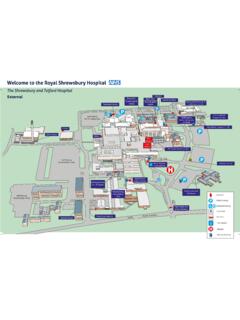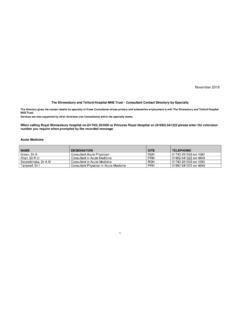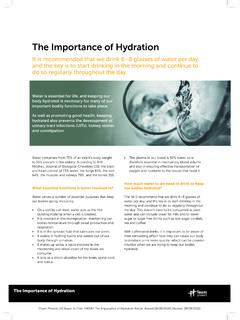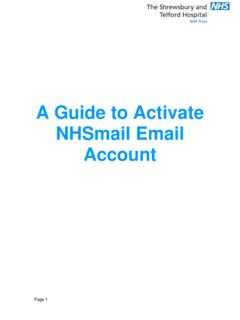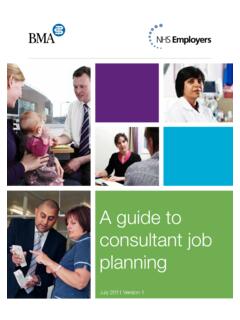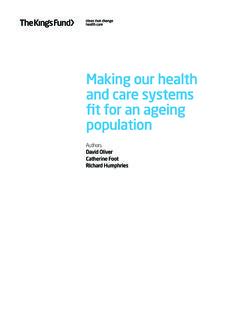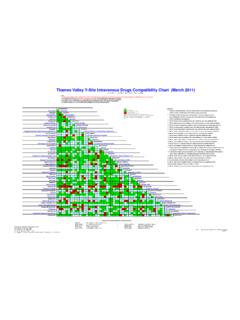Transcription of National Clinical Guidelines - SaTH
1 National Clinical GuidelinesIndexThis index has been formulated in alphabetical order; page numbers have been excluded to enable future Guidelines to be added. Foreward Introduction to National Stoma Care Clinical GuidelinesAuthors Colostomy Irrigation Discharge Guideline for Stoma Care Fistula Management Granuloma Management High Output Stoma Management - Hospital setting High Output Stoma Management - Community setting Leakage Management Pancaking Parastomal Hernia Prevention Parastomal Hernia Management Peristomal Skin Soreness Prolapsed Stoma Stenosis Stoma SitingASCN STOMA CARE Clinical Guidelines 2016 ForewardI am delighted to be writing this foreword within my role as inaugural and current chairperson of ASCN primary aim of the ASCN UK is to support and promote the speciality of stoma care nursing. Within the ASCN strategy, the committee recognises there is currently limited structured, academic specialist courses available.
2 Therefore, the provision of specialist training, education and development opportunities and the need to establish a central resource for stoma care has been is a recognised fact that many experienced Stoma Care Nurses (SCN s) are retiring; taking with them a wealth of expertise and specialist knowledge and Clinical experience. Unfortunately, not all new SCN s to post have the benefit of specialist support, some being lone workers. We perceive these evidenced based Clinical Guidelines will evolve into a comprehensive resource and foundation for practice available to all UK SCN s. Patient experience and improved patient outcomes are a high priority for all SCN s. However, this can only be achieved through safe and effective care which needs to be delivered within a systematic approach enabling equality and consistency in practice. These Stoma Care Clinical Guidelines in conjunction with the ASCN Stoma Care Standards provide the evidence to underpin practice and provide measureable expected would like to express my sincere thanks to all who have invested a significant amount of time and commitment to this credible resource.
3 Working together enables the speciality to be promoted and ultimately strive towards all our patients receiving consistency of high quality Hanley RGN, ENB 216 Clinical Nurse Specialist Stoma CareChair ASCN UK January 2016 ASCN STOMA CARE Clinical Guidelines 2016 Introduction to National Stoma Care Clinical GuidelinesA key objective for The Association of Stoma Care Nurses UK (ASCN UK) is to promote the art and science of stoma care nursing. One of the primary aims within our strategy is to improve facilities and opportunities for nurses to further their skills in the profession of specialist stoma care nursing. For our patients, there is a need to promote continuity of quality care by specifying expert practice grounded in evidence based knowledge and the need to improve care the evaluation of the ASCN UK Standards, requests for National stoma care Clinical Guidelines led to the development of this document.
4 A meeting with the ASCN UK area representatives and committee members identified thirteen Clinical Guidelines for this first phase of the resource. Each guideline has been written utilising the same format as the Stoma Care Standards, the National Institute of Clinical Evidence (NICE) structure, process and outcome framework, to describe a level of excellence in care delivery and a measure against which practice may be audited. It also provides a structured training aid for nurses new to the speciality of stoma care. In 2016 we will be working on evolving this resource further by adding additional Clinical Guidelines to the document (for example removal of urostomy stents). We are aiming for each stoma care department to have one hard copy of the collated Guidelines , but are encouraging each guideline to be viewed as an individual document which can be either copied and shared with other healthcare professionals caring for patients with a stoma, or printed off from our website.
5 As chair of this project to initiate these Clinical Guidelines , I am extremely grateful to the authors for their time and expertise in contributing to this excellent practical resource, and to the committee and area representatives across the UK for peer reviewing all of the current Guidelines . This resource having been collated and written by specialists, applying relevant and available evidence, has been extensively peer reviewed to ensure it is representative for all specialists in stoma care. Ultimately a consensus has been achieved with endorsement by all the peer reviewers that these Clinical Guidelines are to stipulate and specify National Clinical Guidelines that will guide and promote consistency and continuity of care. In addition to all the authors identified within the index, I would like to acknowledge the following Clinical Nurse Specialists in Stoma Care who have peer reviewed these Guidelines :Iris Williams, Katy Timms, Mary Kane, Michaela Parker, Simon Turley, Toni Johnson, Vicky PreeceAdditional appreciation goes to the working party of the parastomal hernia working group which evolved following the ASCN parastomal hernia master class workshop held in July 2015.
6 Wendy Osborne - Project Lead ASCN Educational committee member, Clinical Lead, Coloplast LtdGerry Reid Senior Physiotherapist, Oxford University Hospitals NHS Foundation TrustJacqui North Clinical Nurse Specialist Stoma Care, Hollister LtdJulie Burton Lead Nurse Colorectal and Stoma Care, Yeovil District Hospital NHS Foundation TrustLiz Harris Clinical Nurse Specialist Stoma Care, royal berkshire Hospital Mr Neil Smart Consultant Colorectal Surgeon, royal Devon and Exeter Hospital And additional specialist peer reviewers for this particular guideline:Alison Crawshaw, Angie Perrin, Judy Hanley, Maddie White, Pip ChandlerWendy Osborne (RGN, MSc, ENB 216)Project lead & Education Officer, ASCN UKCNS Stoma Care & Clinical Lead, Coloplast LtdASCN STOMA CARE Clinical Guidelines 2016 ColoplastHollisterUniversity of Birmingham NHS Foundation TrustBasingstokeColoplastRoyal berkshire Hospital.
7 ReadingOxford University Hospitals NHS Foundation TrustOxford University Hospitals NHS Foundation TrustUniversity of Birmingham NHS Foundation TrustThe Queen Elizabeth Hospital King s Lynn NHS Foundation TrustHollisterHollisterExeterThe Queen Elizabeth Hospital King s Lynn NHS Foundation TrustColoplastAshford & St Peter s NHS Foundation TrustColostomy IrrigationDischarge Guidelines for Stoma CareFistula ManagementGranuloma Treatment on the Muco-cutaneous JunctionHigh Output Stoma Management - HospitalHigh Output Stoma Management - CommunityLeakage ManagementPancakingParastomal Herniation - PreventionParastomal Herniation - ManagementPeristomal Skin SorenessProlapseStenosisStoma Siting Author Job title Organisation Wendy OsborneCarole SwashMaddie WhiteEmma MaltbyClaire LowtherGillian TomsettJo PragnellJo PragnellMaddie WhiteGill SkipperJacqui NorthJacqui NorthTracy HollandGill SkipperWendy OsborneCarol Katt Clinical LeadClinical Nurse Specialist- Stoma CareColorectal Nursing Team LeaderStoma Nurse SpecialistNurse ManagerLead CNS Stoma CareAdvanced Nurse PractitionerAdvanced Nurse PractitionerColorectal Nursing Team LeaderAdvanced Nurse Practitioner Stoma CareClinical Nurse Specialist- Stoma CareClinical Nurse Specialist- Stoma CareColoplast Care NurseAdvanced Nurse Practitioner Stoma CareClinical LeadSenior Specialist Nurse Stoma CareStoma Care Clinical Guidelines - Authors ASCN STOMA CARE Clinical Guidelines 2016 Colostomy Irrigation Statement.
8 Appropriate patients with a descending/sigmoid colostomy are offered the management choice of colostomy irrigation (CI). Structure:The patients are assessed and taught by a specialist Stoma Care Nurse (SCN) experienced in CI. Process: Prior to commencement of any CI documented consent from a surgical consultant must be obtained to eliminate any physiological contra-indications Ensure a private, confidential and safe environment where the patient can be assessed, treatment given and provided with information Utilising advanced specialist assessment - undertake a Clinical history to assess your patient s psycho/ physiological status excluding any contra-indications (Appendix 1a) Initiate provision of training DVD, written literature ( Colostomy Association), equipment and allow patient time to review this information. Offer patient opportunity to speak with another irrigator Talk through the procedure with the patient involve significant others with patient s consent Advise of potential complications and risks of CI Reassure CI is not successful for everybody and this is not a failure Evaluate patient s understanding and ability to undertake the procedure independently Promote a routine to the CI procedure as identified in CA leaflet Obtain verbal/written consent from patient as per local policy Agree a training and follow up plan with patient and CI expert Key recommendations ascertained from current literature and expert practice (Appendix 1b)
9 For the first practical undertaking of CI it is advised CI is undertaken within the acute setting where additional medical support is available to call upon if required due to risk of vagus nerve stimulation, however this will need to be assessed on an individual basis Initiate CI every 24hrs, (for some patients every 48hrs) ascertain a time suitable for the individual, and advise to keep to this time of day Start with 300-500mls of tepid water, and increase/titrate amount of water until no breakthrough not exceeding (consider administering half this amount, allow bowel to evacuate then repeat. Some patients need a second administration of water to achieve effective evacuation and prevent breakthrough) If no breakthrough for 24hrs, discuss option of trialling decreasing CI to every 48hrs and monitor effectiveness Time and relaxation maximises effectiveness - water to be run in slowly (min.)
10 10-20mins), Allow evacuation of bowel for approx 15-30mins Allow 6-8 weeks for bowel to regulate and get used to CI The individual is to be made aware of the choice of gravity and mechanical pump available this will be subject to cost implications depending on your local area. NB: The recommendations above will therefore need to be amended if a mechanical pump is used Maintain telephone support and offer a follow up review at home or hospital in accordance to the patients needs to discuss any problems and offer encouragement Review in clinic as per local colostomy patient follow up :Patient states the nurse offered advice and expertise on the management of their stoma and CI. Patient able to undertake CI effectively. Patient expresses satisfaction in : WENDY OSBORNEASCN STOMA CARE Clinical Guidelines 2016 Appendix 1a: Colostomy Irrigation ChecklistDate:CNS Name:Patent Name: Patient NHS No.
